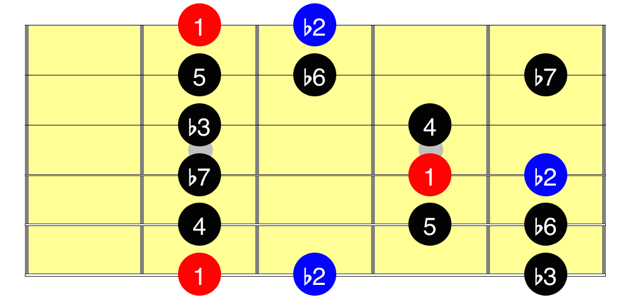Guitar modes: how to learn all 7 major modes the easy way
A quick-fire route to memorizing and mastering the modes

When learning how to play the seven major modes on guitar, most of us begin with the Ionian mode then move on to Dorian and progress up the fretboard in this way until we’ve learned all seven positions of the major scale.
While this can be an effective way of learning modes, in this lesson you will learn a shortcut that will allow you to quickly and easily learn all seven modes by starting with Lydian and simply lowering one note at a time until you can play all seven modes on the fretboard.
When learning the modes in this way, by changing one note between each subsequent mode, you will practice them out of the normal order.
Here is the normal order of the major modes on guitar for review.
- Ionian
- Dorian
- Phrygian
- Lydian
- Mixolydian
- Aeolian
- Locrian
When working them from the one-note changing perspective, you wind up with this order of modes.
- Lydian
- Ionian
- Mixolydian
- Dorian
- Aeolian
- Phrygian
- Locrian
Start by learning the modes, memorizing them in the new order so you can use the one-note changing method. From there, you can go back and play them in the original order when putting them together in one key on the fretboard.
Doing things this way will allow you to quickly learn the modes and then bring them back into normal order, rather than learning them as seven distinct fingerings in normal order from the beginning.
A quick note about the chord grids below. There are three colors on each grid – here is the legend for those colors.
- Red: Root note for that mode
- Black: Static notes between the last mode and this mode
- Blue: The one note that has been moved from the previous mode to form the new mode you are playing
Now that you know a bit about the concept we're exploring today, let’s take it to the fretboard.
Lydian mode
To begin mastering the modes on guitar, you are going to learn the Lydian mode, which contains one sharp in its construction, the #4. This is going to be the base mode for all seven shapes, so make sure to get this shape down comfortably before moving on to the next mode in the system.

Ionian mode
Now you will take the Lydian mode you just learned and alter one note to form the Ionian mode. In this case, you will lower the 4th note of Lydian to produce the Ionian fingering.

Mixolydian mode
Continuing on to the final major-based mode, you will now alter the Ionian mode by one note to form a Mixolydian mode fingering. When doing so, you lower the 7th of Ionian to form the Mixolydian mode.

Dorian mode
We can progress to the minor modes now as you alter one note of Mixolydian to form the Dorian mode. Here, you will lower the 3rd of Mixolydian to form the Dorian mode fingering.

Aeolian mode
To form the second minor mode, you will lower one note of Dorian to produce the Aeolian mode on the fretboard. To do so, you will lower the 6th of Dorian to form the Aeolian fingering.

Phrygian mode
Next in our quest to learn the modes on guitar, you will lower one note of Aeolian to form the Phrygian mode. When doing so, you lower the 2nd of Aeolian to form the Phrygian fingering on the fretboard.

Locrian mode
Lastly, you will take the Phrygian mode and lower one note to produce the Locrian mode. Here, you lower the 5th note of Phrygian to produce the Locrian fingering.

As you can see, by starting on Lydian and lowering one note at a time, you can quickly and easily build and memorize all seven major scale modes on the guitar. Also, you will be able to see and hear how closely related these modes are, which isn’t always apparent when learning all seven fingerings on their own in the more traditional manner.
Learning modes exercises
Once you've worked out each of these seven major modes on the note G, you can try out the following exercises to help you solidify these shapes further in your studies.
- Play through all three major modes: Lydian-Ionian-Mixolydian from one root note. Repeat in 12 keys.
- Play through all four minor-based modes: Dorian-Aeolian-Phrygian-Locrian from one root note. Repeat in 12 keys.
- Play all seven major modes in the order presented at the start of this lesson from one root note. Repeat in all 12 keys.
- Put on a major chord backing-track, such as G, and solo over this chord moving between Lydian, Ionian and Mixolydian to hear how these modes color a major chord in a soloing situation.
- Repeat this soloing exercise but put on an Am backing track and solo between A Dorian, Aeolian, Phrygian and Locrian.
- Repeat exercises 4 and 5 in all 12 keys. Then, begin to move between two chords, so G-C or Am-Dm, and work all seven modes over both of those chord progressions.
Get The Pick Newsletter
All the latest guitar news, interviews, lessons, reviews, deals and more, direct to your inbox!
Matt Warnock is the owner of mattwarnockguitar.com, a free website that provides hundreds of lessons and resources designed to help guitarists of all experience levels meet their practice and performance goals. Matt lives in the UK, where he teaches Skype guitar students all over the world, and is an examiner for the London College of Music (Registry of Guitar Tutors).









![Joe Bonamassa [left] wears a deep blue suit and polka-dotted shirt and plays his green refin Strat; the late Irish blues legend Rory Gallagher [right] screams and inflicts some punishment on his heavily worn number one Stratocaster.](https://cdn.mos.cms.futurecdn.net/cw28h7UBcTVfTLs7p7eiLe.jpg)
